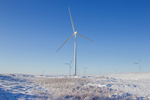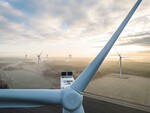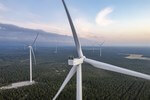11/30/2007
China - Bidding to open on fifth annual round of wind farm projects
China is about to open the bidding for development rights to large-scale wind farm projects across the country, marking the fifth annual round of such bidding to be undertaken in the country, a senior industry association official said.
Shi Pengfei, the vice chairman of the Chinese Wind Energy Association (CWEA), said that bids will begin to be accepted by the National Development and Reform Commission (NDRC) on Nov. 30, and that the results of the will be released around one month after that.
Due to a new assessment system put in place for this round of bidding, bidders who propose a feed-in tariff closest to the average feed-in tariff for all other bids in a pool for a wind farm will be the most likely to win the rights to the project, according to Shi.
Some companies have already revealed their bidding intentions, with Shenzhen Energy Investment, a Shenzhen-based power producer, announcing today that it intends to bid for the rights to one wind farm in Inner Mongolia and another in Hebei Province.
Although the Chinese government is yet to reveal detailed information about the upcoming bidding round, Shenzhen Energy Investment's statement said that four wind projects are going to be put up, including a 150-megawatt wind farm project in Chengde City in Hebei Province, a 200-MW project in Jiuquan City in Gansu Province, a 300-MW project in Bayan Nur in Inner Mongolia and a 300-MW project in Tongliao City, also in Inner Mongolia.
China's wind power regulatory system requires that any project with an installed capacity of over 50 MW be approved by the central government's NDRC. In an effort to manage this system and help facilitate domestic wind power development, the development rights to some large projects are put up for bidding by the NDRC each year.
Shi noted that the government has no set standard for deciding which wind farm projects should be put through the national bidding system, and which projects should be developed independently. Projects with a proposed installed capacity of less than 50 MW do not need national approval though, and thus can be handled by provincial-level branches of the NDRC.
Projects undertaken through this national bidding system receive some government support in the form of wind resource evaluations and feasibility studies, and any power transmission facilities required for the wind farms are developed at the cost of the power grid companies. Such projects are also required to be comprised of over 70 percent Chinese-manufactured equipment.
Also, when submitting bids for specific wind farm projects, bidders must propose a feed-in-tariff. Winning bidders are guaranteed to receive their proposed feed-in tariffs for all electricity produced at their wind farm during the first 30,000 hours of operation. After this period is up, the wind farms then receive the average feed-in tariff for the region.
China conducted its first round of such bidding in 2003, and during the first two years, the government chose winning bids based solely on their proposed feed-in tariffs. The system was changed for both the third and fourth rounds, with the importance of feed-in tariffs declining, to become weighted at 40 percent and 25 percent respectively.
However, during these third and fourth rounds, bidders who quoted the lowest on-grid tariff in each pool were still the most likely to achieve success.
He Dexin, chairman of the CWEA, told Interfax that some companies proposed relatively low feed-in tariffs for projects during the four annual bidding rounds. He noted that some state-owned companies were prepared to gain the construction rights to wind farms with initially low feed-in tariffs and endure the resulting short period of unprofitability in order to expand their market share and thereby guarantee future profits.
According to He, if the average annual utilization hours for wind turbines at a wind farm are below 2,000 hours, such a wind farm will struggle to make any money with a feed-in tariff below RMB 0.50 ($0.068) per kilowatt hour.
Shi noted that some projects with an installed capacity of less than 50 MW can receive better feed-in tariffs from provincial-level governments. Such an approach is not always successful though, as feed-in tariffs offered by provincial governments still need to be approved by the NDRC.
Shi Pengfei, the vice chairman of the Chinese Wind Energy Association (CWEA), said that bids will begin to be accepted by the National Development and Reform Commission (NDRC) on Nov. 30, and that the results of the will be released around one month after that.
Due to a new assessment system put in place for this round of bidding, bidders who propose a feed-in tariff closest to the average feed-in tariff for all other bids in a pool for a wind farm will be the most likely to win the rights to the project, according to Shi.
Some companies have already revealed their bidding intentions, with Shenzhen Energy Investment, a Shenzhen-based power producer, announcing today that it intends to bid for the rights to one wind farm in Inner Mongolia and another in Hebei Province.
Although the Chinese government is yet to reveal detailed information about the upcoming bidding round, Shenzhen Energy Investment's statement said that four wind projects are going to be put up, including a 150-megawatt wind farm project in Chengde City in Hebei Province, a 200-MW project in Jiuquan City in Gansu Province, a 300-MW project in Bayan Nur in Inner Mongolia and a 300-MW project in Tongliao City, also in Inner Mongolia.
China's wind power regulatory system requires that any project with an installed capacity of over 50 MW be approved by the central government's NDRC. In an effort to manage this system and help facilitate domestic wind power development, the development rights to some large projects are put up for bidding by the NDRC each year.
Shi noted that the government has no set standard for deciding which wind farm projects should be put through the national bidding system, and which projects should be developed independently. Projects with a proposed installed capacity of less than 50 MW do not need national approval though, and thus can be handled by provincial-level branches of the NDRC.
Projects undertaken through this national bidding system receive some government support in the form of wind resource evaluations and feasibility studies, and any power transmission facilities required for the wind farms are developed at the cost of the power grid companies. Such projects are also required to be comprised of over 70 percent Chinese-manufactured equipment.
Also, when submitting bids for specific wind farm projects, bidders must propose a feed-in-tariff. Winning bidders are guaranteed to receive their proposed feed-in tariffs for all electricity produced at their wind farm during the first 30,000 hours of operation. After this period is up, the wind farms then receive the average feed-in tariff for the region.
China conducted its first round of such bidding in 2003, and during the first two years, the government chose winning bids based solely on their proposed feed-in tariffs. The system was changed for both the third and fourth rounds, with the importance of feed-in tariffs declining, to become weighted at 40 percent and 25 percent respectively.
However, during these third and fourth rounds, bidders who quoted the lowest on-grid tariff in each pool were still the most likely to achieve success.
He Dexin, chairman of the CWEA, told Interfax that some companies proposed relatively low feed-in tariffs for projects during the four annual bidding rounds. He noted that some state-owned companies were prepared to gain the construction rights to wind farms with initially low feed-in tariffs and endure the resulting short period of unprofitability in order to expand their market share and thereby guarantee future profits.
According to He, if the average annual utilization hours for wind turbines at a wind farm are below 2,000 hours, such a wind farm will struggle to make any money with a feed-in tariff below RMB 0.50 ($0.068) per kilowatt hour.
Shi noted that some projects with an installed capacity of less than 50 MW can receive better feed-in tariffs from provincial-level governments. Such an approach is not always successful though, as feed-in tariffs offered by provincial governments still need to be approved by the NDRC.
- Source:
- Online editorial www.windfair.net
- Author:
- Edited by Trevor Sievert, Online Editorial Journalist
- Email:
- press@windfair.net
- Link:
- www.windfair.net/...
- Keywords:
- wind energy, wind farm, renewable energy, wind power, wind turbine, rotorblade, offshore, onshore


























